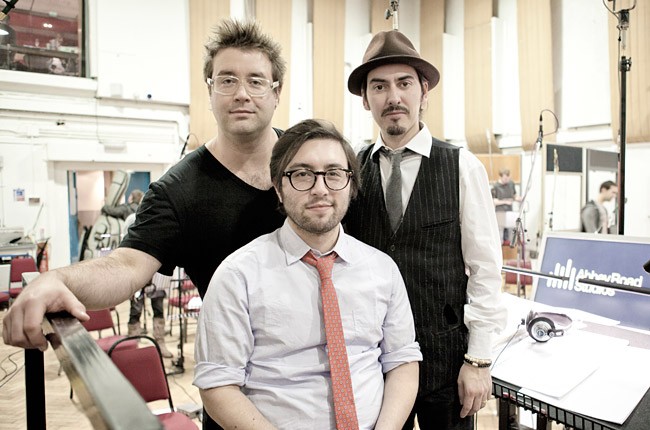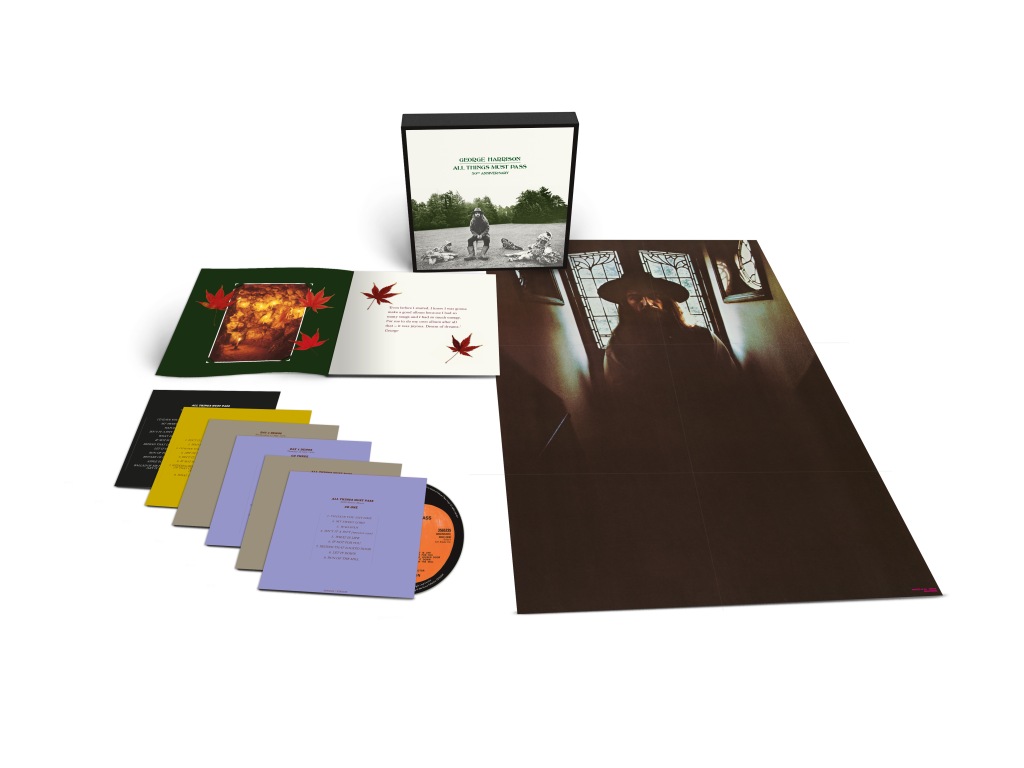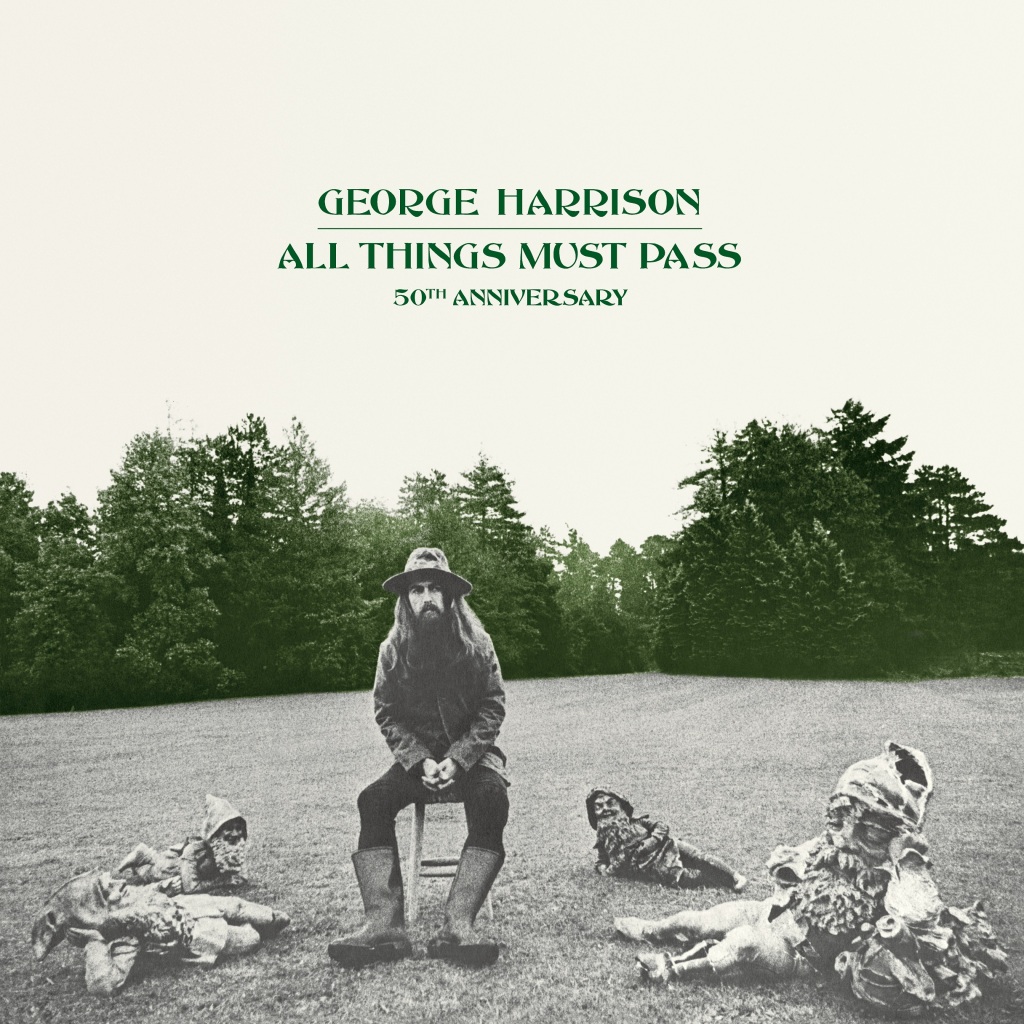
In celebration of the 50th anniversary “All Things Must Pass,” several expanded editions of the album were made available, showcasing a new remix and a bounty of revelatory outtakes and demos. The project lovingly was overseen by Harrison’s son, Dhani, and British musician and audio engineer Paul Hicks, the son of guitarist Tony Hicks of the Hollies. The younger Hicks also has worked on some John Lennon reissues. Beatlefan Contributing Editor Ken Sharp talked with Hicks about his work. …
Paul, you’ve known Dhani Harrison for many years, right?
Yeah, I’ve known Dhani for a long time. We were school friends. I’m a tiny bit older than him. Me and my family lived in Henley and George lived in Henley. So, my dad knew George. It was one of those funny rock ’n’ roll connections. Dhani and I were at different schools, but I actually got to know Dhani via a friend, whose dad was Ian Paice of Deep Purple. We’re both only children and, yeah, we just became friends. I would sort of go around there to his home at Friar Park and I knew George as well.
You worked directly with George on “The Beatles Anthology.” Did you ever have any musical conversations?
Not really. I think in the early days he was really pleased, because I enjoyed listening to Indian music. I was a big fan of Ravi Shankar and I actually went with George and Dhani to a Ravi Shankar concert, which was a great experience. I remember one of the first times I met him, he gave me some Ravi stuff. There were also a couple of times I sort of jammed with George, but there weren’t that many discussions. I mean, maybe just about music in general.
But, then I worked with him when I joined Abbey Road [Studios] and I started on “The Beatles Anthology.” I was more of a friendly face. I joined Abbey Road in ’92, ’93 and then literally I was there for about six months as an assistant, because of my dad. I knew quite a few people, so there was a little bit of an ease of starting up there. But, obviously, I worked incredibly hard.
After six months, The Beatles’ anthologies were starting up and they asked if I wanted to assist Geoff Emerick in the penthouse and spend months going through the material for one of the anthologies. It was quite amazing. Everything was done totally analog, so it was like an amazing bit of training. I learned how to edit analog. So, yeah, it was a very special experience, and that experience helped me throughout life.
When you see the footage of George, Paul and Ringo with George Martin, listening back to Beatles session tapes in the control room, George seems quite engaged.
Yeah, absolutely. He was really into it and up for it. I think, in that footage in the studio, there might be one glimpse of me. I’m in the back room. Paul, George and Ringo came in every now and again.
It was a great start, and it led me to continue with Beatle stuff for many years. When all three of them were in the room together, it was a lot of fun. It was brilliant. I’d met them all individually, and everyone was enjoying themselves, listening to it, and having a good time.

In terms of the “All Things Must Pass” project, what was the biggest challenge for you?
The biggest problem on this one was the overall balance of what we wanted to accomplish. I think that was the biggest thing, because you had people saying, “Can you do this?” “Can you do that?” Some people wanted a “Let It Be … Naked” version. And, then, some people don’t want it touched. [laughs] But, there’s a middle ground.
The things I’ve been doing recently with the Lennon [reissues], like the “Plastic Ono Band” box, everyone’s been reacting really positively to that.
We felt … let’s experiment with this. So, to be honest, when I say a balance, what a lot of people don’t realize is there are limitations of what you can do with all this stuff. There’ll be some tracks that they may have put the reverb on at the end. There’s some tracks that they literally recorded the reverb on with the instruments. The biggest case in point is “Wah-Wah,” where it’s a stereo guitar track of multi guitars and there’s plate reverb already printed on it.
So, that basically makes it balance out that, even if we wanted to, you could never do a fully dry version. But, to be honest, there were a couple of times when we did try that, like on “Apple Scruffs,” which had that slap delay, but if you take that off, it basically sounds like an outtake.
There are decisions that have to be made. … So, we did a high-res transfer and then the process that I always do with all of these projects, which is helpful in many ways, is taking a bit of time spent matching and trying to basically re-create the mix that was done. So, sonically, you try and match the reverbs; you do this and that.
Obviously, different tracks have different variants of how much different stuff there is. But, there’s quite often a couple of vocal takes, and you have to do the research and find out. You think it’s all on this one track, but then there will be, like, two words from another track. So, you have do quite a lot of forensic work to make sure you’ve got the right pieces and right parts.

So, that’s always the process that we start with. When you A/B it, it’s as similar as we can make it, and then you take a little step back from it and think, well, how can we improve this? And I’ve found this with quite a lot of that era, that you don’t really notice it until you’re listening, until you do comparisons, but the vocals are quite quiet in a lot of it … that happens a lot.
So, the vocals are pretty buried, and I think, nowadays, there’s a bit more low end we can get out of it and control it. So, what we did was, we went through and we mixed the album a few times, just to get it right. So, we did one version, which was very similar, but just the vocals were a bit clearer. And, then, we were like, if we’re gonna do this, we might as well do it. So, then we did a version and really sort of went for it. We eventually settled on a version which was a good balance of the original album with some enhancements. We think it all feels right. One of the things we were specifically aware of is that George told Dhani — and he even told me once, and you can hear with some of the things he did with Jeff Lynne — he wasn’t a fan of reverb on his voice, so we kept that into consideration.
And, [George] did try. I think, when he was remastering it years ago [2001], I think he did sort of give it a go to try and take all the reverb down. But, there wasn’t the technology that there is now, so he didn’t.
So, we came to a version that we think has just more clarity, really. With all this stuff, you’ve got to be very careful. We’re very respectful with the originals.
As I said, with a lot of these things, when I’m working on Lennon things there’s Yoko [Ono] and Sean [Lennon], and, with this album, there’s Olivia [Harrison] and Dhani, and Dhani knows exactly what George always liked, so we’re never going into this blind. There’s always a lot of those sort of processes involved in it.
You touched on the biggest challenges. By contrast, what was the greatest joy working on this project?
The greatest joy is when people say, “Oh, it sounds really good.” Excellent. Thank you.
Another big joy is when you make a discovery.
You know, the biggest joy is when you do a mix and everyone’s happy with it.
What were some of the most revelatory discoveries in the tape vault for you?
There’s two parts to that. Within the masters, there was lots of overdubs. It was an eight-track thing. But, there’s not a crazy amount of things on the master tapes that people wouldn’t know about. On “Isn’t It a Pity” Version 1, George had his synth and, in the song, there’s a really fizzy sort of noisy synth, and you don’t really notice it, but then, when you solo it, you hear it all. It almost sounds like a bit of the orchestra or something, or part of the guitar. But, once you hear it, you can’t unhear it. You’re very tempted to really push those elements up, but you’ve got to do it in context. But, I think people listening with their headphones on, we’re giving people just a little peek into some elements of the mix that may have been cleaned up a touch, and people can hear them better.
Another thing is, we found a great selection of outtakes, as well. There’s some songs where he really didn’t do that many takes, and then there’s other ones that went through various versions.

Do you recall which of the songs had the most takes, where George was really trying to find a window into the essence of the song?
Yeah. “Run of the Mill” is a great one. The one they put out on video, with those dual lead guitars, was Take 36. So, he was going through quite a lot of those.
I can’t remember which ones had the most takes. Another favorite is “I’d Have You Any Time,” which had a really cool piano. We tried to select versions that showed some sort of progress, because we included the recordings from Day 1 and Day 2, as we decided it’d be great idea, historically, to include the whole thing, every song from those sessions. So, you’ve got a complete Day 1 and Day 2, and then you’ve got what we affectionately call the “party” disc. A lot of the outtakes are a little bit more upbeat, and have a bit more stuff going on, which I think is absolutely fascinating.
There’s a groovy “Awaiting on You All,” stripped back. There’s some really groovy ones. There’s an “I Dig Love,” which is great. As much as I think they’re fantastic versions, as with a lot of these things, there’s a reason George didn’t select them for the finished record, and I think he made the right decision. For example, with “I’d Have You Anytime,” the version is so beautiful that’s on there, and they made the right emotional decisions on a lot of them.
The “Plastic Ono Band” and “Imagine” super deluxe edition sets are an almost forensic approach of, we’re gonna give you everything. But, there was a different ideology behind this “All Things Mist Pass” project.
Yeah, exactly. It was just more about, this is the album, we wanted to treat it all as songs. So many people have asked for so many different versions of it that we’re, like, enjoy the main album and then make your own version. [laughs] If you like the acoustic version, make a playlist and have fun with it.
But there was never thought of, a la the Lennon “Plastic Ono Band” box, here’s 37 takes of “Beware of Darkness”?
No, no. Because, to be honest, if you include the jams, it’s a three-album thing. It’s physically so much content. You’re talking a lot of songs; there’s already a lot of stuff on there. So, it’s a balancing act. There’s a lot of thought that goes in, and sometimes there might be a fantastic version of a song and then something’s not right, you know, either a guitar is not right or a vocal is not right.

Could you explain the “ultra mastering technique” Dhani described that was employed with the album?
It’s a side thing. Disc 3, the jams, was a remaster, because it’s only stereo. They literally ran the tape while they were jamming, so there’s no multi-track. So, we did a really high-resolution remaster on that one. I think it’s come out really good. But, basically, what Dhani was meaning is, we’re not trying to completely change anything. We’re just trying to do a really good new version and new mix. What he meant by ultra remastering is, we can go further than we can with a stereo remaster. We are trying to reference the old mixes but there’s more clarity, there’s more low end, there’s top end in the clarity itself. One of the things I never want to do with any of this stuff is make it sound modern. I say this to everyone, someone mentioned timeless once, and I said, yeah, that’s exactly what we want to do. We don’t want it to sound like it was done today. But, we also want to take advantage of the technology and want to sonically improve things and really make it sound timeless. You know, it’s the same process I’ve done with “Plastic Ono Band” and the other Lennon projects that we’ve been doing recently. It’s all about that same principle, make it timeless sounding and don’t push things too far.
What’s the state of George’s tape archive?
It’s all organized and logged, and it’s looked after.
You and Dhani mixed 110 tracks.
Yes. We mixed it all, and then worked out what we wanted to use.
I wonder if any future project will be able to tap into any of those other additional mixed tracks?
Yeah. We chose the best of the best. A lot of the times it was between two versions that were really similar, and it was like, right, which is better? So, as far as I’m concerned, there’s no treasure trove still left to go through. This is pretty much the best of the best.
Working so deeply on this record, where it’s now part of your DNA, what impresses you the most about “All Things Must Pass?”
I think was a great showcase for George’s songwriting and playing, and I think it really showed the world what a great musician he was. I think the more you live with this record, the more you realize there were so many messages in it. It’s a heavy emotional album, isn’t it? It dealt with a lot of quite interesting subject matter, especially at the time, with religion and different emotions and things.
I think one of the songs I was most pleased about was “I Dig Love.” That’s a great little song. I think we’ve managed to get some good things out of that one. There’s a few that we’ve really managed to make it emotionally sort of shine through.
You can find more of Ken Sharp’s conversations with musicians and others involved in the making of the original “All Things Must Pass” album in Beatlefan #251 and #252.
